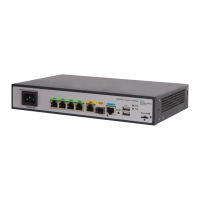91
Local mode
Operation mode of the local device:
• unspec—The mode is unspecified.
• active—Active mode.
• passive—Passive mode.
• client—Client mode.
• server—Server mode.
• broadcast—Broadcast or multicast server mode.
• bclient—Broadcast or multicast client mode.
Reference clock ID
For an IPv4 NTP server:
The field represents the IP address of the remote server when
the local device is synchronized to a remote NTP server.
The field represents the local clock when the local device uses
the local clock as the reference source.
• When the local clock has a stratum level of 1, this field
displays LOCL.
• When the local clock has any other stratum, this field
displays the IP address of the local clock.
For an IPv6 NTP server:
The field represents the MD5 digest of the first 32 bits of the
IPv6 address of the remote server when the local device is
synchronized to a remote IPv6 NTP server.
The field represents the local clock when the local device uses
the local clock as a reference source.
• When the local clock has a stratum level of 1, this field
displays LOCL.
• When the local clock has any other stratum, this field
displays the
MD5 digest of the first 32 bits of the IPv6
address of the local clock.
Leap indicator
Alarming status:
• 00—Normal.
• 01—Leap second, indicates that the last minute in a day
has 61 seconds.
• 10—Leap second, indicates that the last minute in a day
has 59 seconds.
• 11—Time is not synchronized.
Clock jitter
Difference between the system clock and reference clock, in
seconds.
Stability
Clock frequency stability. A lower
stability.
Clock precision Accuracy of the system clock.
Root delay
Roundtrip delay from the local device to the primary time
server, in milliseconds.
Root dispersion
Maximum error of the system clock relative to the primary time
server, in milliseconds.
Reference time Reference timestamp.

